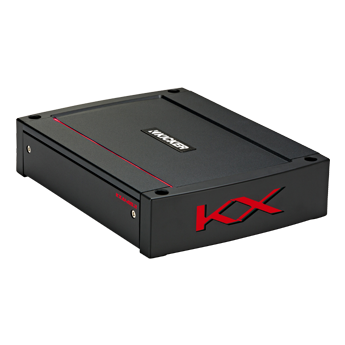Amps
Adding a Car Amp
If you are planning to add a sub to your car’s audio system or are unhappy with the sound levels of your current speakers, car amps may solve all of your issues. An amplifier can deliver the power your stereo system desperately needs, allowing you to truly feel your music while commuting through the Boston area.
You can be assured that our experienced team at ProCarSound&Security can help add an amplifier to your setup and rejuvenate your sound.

What Does A Car Amp Do?
As the name implies, a car amp amplifies the power of the signal sent from the receiver to a speaker. The amplifier does not change what the actual signal is. It only makes the signal itself stronger. This signal strengthening property brings benefits such as:
- Overall Better Sound Quality. The power output of a factory receiver and even many aftermarket stereos is not great. Amplifying a signal requires room for extra transistors and other electrical components. With car receivers having to accommodate many other features, there is not enough room for signal amplification. As such, you may notice that at higher volume levels, your audio may start to distort as the receiver struggles to deliver clean power. An amplifier is dedicated to explicitly strengthening the signal and allows for your music to be distortion-free at higher volumes.
- Power Upgraded Speakers. If you plan to upgrade your speakers or recently installed a car speaker, the new speakers may require more energy to drive them efficiently. You can replace your receiver with one that can output more power from the get-go. However, you can also add an amplifier to handle the increased power requirements.
- Powering a Subwoofer. If you plan to add a subwoofer to your system, you will need an amplifier to handle the higher power requirements.
Do Car Subwoofers Need An Amp?
If you plan to install a car subwoofer, you will need an accompanying car amp. The power requirements to drive a subwoofer are much higher than those for regular woofer speakers or tweeters.
It is implausible that your car’s radio can output the required power to drive your subwoofer efficiently. If you hooked up without an amplifier, you would get an extremely muddy sound or an output that isn’t audible.
There is, however, an exception. If you opt for a powered subwoofer, you will receive a subwoofer already enclosed with an amplifier. In this scenario, you won’t need to install a car amp.
What To Look For In A Car Amp
There are various amps for cars that cater to drivers’ needs. While car amps are relatively simple, there are still some variables when choosing a new car amp. Below we have highlighted some of the specifications for a new car amplifier.

Channels
When looking at amps, you will notice that different amps offer different channels. In this context, a channel refers to a line of power that the amp can provide. For each speaker you plan to power, you will require a channel.
The most commonly found channel quantities are two and four-channel amplifiers. A two-channel amp is a cheaper way to get the benefits of amplified sound. Those who install a two-channel amp will only amplify their front two speakers. A two-channel car amp may be sufficient if you do not care for the “rear fill” sound that the rear speakers provide or don’t ride around with rear passengers often.
However, if you want to power both the front and rear speakers, a four-channel car amp will allow the amplification for all four of the main speakers in the cabin.
There are a few more amplifier options if you introduce a subwoofer to the audio setup. It’s common only to want to power the subwoofer, so there are many mono-channel car amplifiers that only provide power for the subwoofer. Three-channel amplifiers also allow you to power your front speakers and a subwoofer. Five-channel and other multi-channel amplifiers will enable you to power your entire audio setup.
Car Amp Class
When browsing amps for a car, you may notice that each amplifier is denoted with a different “class.” These classes will typically be A, B, AB, and D. There are more classes than just these four, but these are the most common.
In summary, these different classes give you an understanding of how each amplifier handles power. For instance, Class A car amps are always on and ready to go. They will provide the least distorted power without needing to switch on their transistors when a signal is displayed. However, since they are always on, they use excessive energy and generate a lot of heat. Class B amplifiers will turn off when there is no signal, meaning there is less energy and heat waste, but the audio fidelity is decreased.
Class AB will be most commonly seen in amps for cars.
These amps will also always stay on but lower the energy usage when no signal is present, mixing the benefits of both Class A and Class B amps.
Class D amps handle their power delivery in a manner that results in distorted sounds at higher frequencies but are incredibly efficient. As such, mono-channel amplifiers responsible for powering subwoofers are all Class D since they are not meant to reproduce high frequencies.

Power
The amount of power that car amps can deliver is represented by its root mean square (RMS) rating. Both amps and speakers will have an RMS rating that you need to correlate to be compatible.
Ideally, you want the RMS of your speakers and amplifier to be the same or as close as possible. Your amplifier’s RMS mustn’t be higher than the RMS of your speakers, as it will cause your audio to distort and lead to potential damage.
Your Local Car Amp Installation Shop
ProCarSound&Security is the place to go if you need a car amp installation in Massachusetts. We can help determine what kind of amp is best for your system and perform all the necessary installation and wiring work to have your car’s audio sounding at its peak.
If you need help finding the best car amp for your car or want to schedule an installation, please don’t hesitate to contact us.







